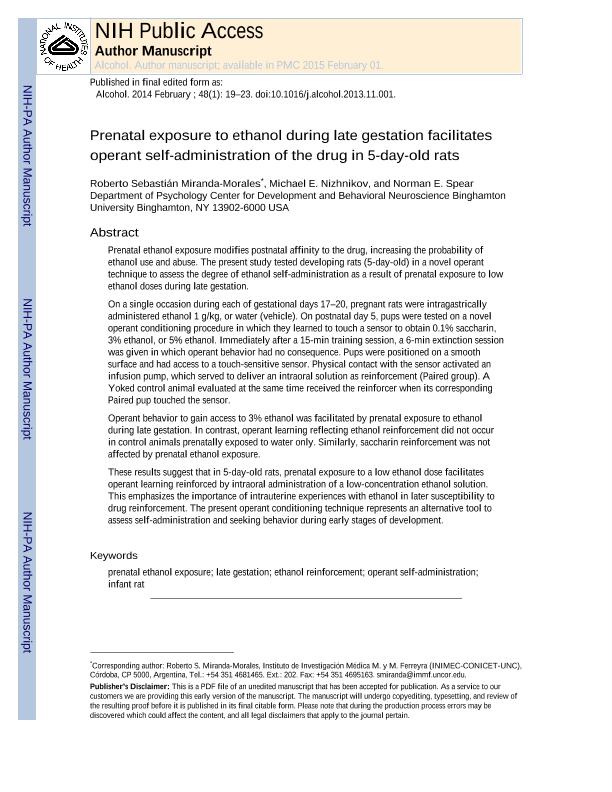Mostrar el registro sencillo del ítem
dc.contributor.author
Miranda Morales, Roberto Sebastián

dc.contributor.author
Nizhnikov, Michael

dc.contributor.author
Spear, Norman E.
dc.date.available
2017-12-27T16:02:14Z
dc.date.issued
2014-02
dc.identifier.citation
Miranda Morales, Roberto Sebastián; Nizhnikov, Michael; Spear, Norman E.; Prenatal exposure to ethanol during late gestation facilitates operant self-administration of the drug in 5-day-old rats; Elsevier Science Inc; Alcohol; 48; 1; 2-2014; 19-23
dc.identifier.issn
0741-8329
dc.identifier.uri
http://hdl.handle.net/11336/31643
dc.description.abstract
Prenatal ethanol exposure modifies postnatal affinity to the drug, increasing the probability of ethanol use and abuse. The present study tested developing rats (5-day-old) in a novel operant technique to assess the degree of ethanol self-administration as a result of prenatal exposure to low ethanol doses during late gestation. On a single occasion during each of gestational days 17–20, pregnant rats were intragastrically administered ethanol 1 g/kg, or water (vehicle). On postnatal day 5, pups were tested on a novel operant conditioning procedure in which they learned to touch a sensor to obtain 0.1% saccharin, 3% ethanol, or 5% ethanol. Immediately after a 15-min training session, a 6-min extinction session was given in which operant behavior had no consequence. Pups were positioned on a smooth surface and had access to a touch-sensitive sensor. Physical contact with the sensor activated an infusion pump, which served to deliver an intraoral solution as reinforcement (Paired group). A Yoked control animal evaluated at the same time received the reinforcer when its corresponding Paired pup touched the sensor. Operant behavior to gain access to 3% ethanol was facilitated by prenatal exposure to ethanol during late gestation. In contrast, operant learning reflecting ethanol reinforcement did not occur in control animals prenatally exposed to water only. Similarly, saccharin reinforcement was not affected by prenatal ethanol exposure. These results suggest that in 5-day-old rats, prenatal exposure to a low ethanol dose facilitates operant learning reinforced by intraoral administration of a low-concentration ethanol solution. This emphasizes the importance of intrauterine experiences with ethanol in later susceptibility to drug reinforcement. The present operant conditioning technique represents an alternative tool to assess self-administration and seeking behavior during early stages of development.
dc.format
application/pdf
dc.language.iso
eng
dc.publisher
Elsevier Science Inc

dc.rights
info:eu-repo/semantics/openAccess
dc.rights.uri
https://creativecommons.org/licenses/by-nc-sa/2.5/ar/
dc.subject
Prenatal Ethanol Exposure
dc.subject
Late Gestation
dc.subject
Ethanol Reinforcement
dc.subject
Operant Self-Administration
dc.subject
Infant Rat
dc.subject.classification
Inmunología

dc.subject.classification
Medicina Básica

dc.subject.classification
CIENCIAS MÉDICAS Y DE LA SALUD

dc.title
Prenatal exposure to ethanol during late gestation facilitates operant self-administration of the drug in 5-day-old rats
dc.type
info:eu-repo/semantics/article
dc.type
info:ar-repo/semantics/artículo
dc.type
info:eu-repo/semantics/publishedVersion
dc.date.updated
2017-12-26T20:37:13Z
dc.journal.volume
48
dc.journal.number
1
dc.journal.pagination
19-23
dc.journal.pais
Estados Unidos

dc.journal.ciudad
New York
dc.description.fil
Fil: Miranda Morales, Roberto Sebastián. Consejo Nacional de Investigaciones Científicas y Técnicas. Centro Científico Tecnológico Conicet - Córdoba. Instituto de Investigación Médica Mercedes y Martín Ferreyra. Universidad Nacional de Córdoba. Instituto de Investigación Médica Mercedes y Martín Ferreyra; Argentina
dc.description.fil
Fil: Nizhnikov, Michael. University Of Binghamton; Estados Unidos
dc.description.fil
Fil: Spear, Norman E.. University Of Binghamton; Estados Unidos
dc.journal.title
Alcohol

dc.relation.alternativeid
info:eu-repo/semantics/altIdentifier/doi/http://dx.doi.org/10.1016/j.alcohol.2013.11.001
dc.relation.alternativeid
info:eu-repo/semantics/altIdentifier/url/http://www.sciencedirect.com/science/article/pii/S074183291300205X
dc.relation.alternativeid
info:eu-repo/semantics/altIdentifier/url/https://www.ncbi.nlm.nih.gov/pmc/articles/PMC3902470/
Archivos asociados
